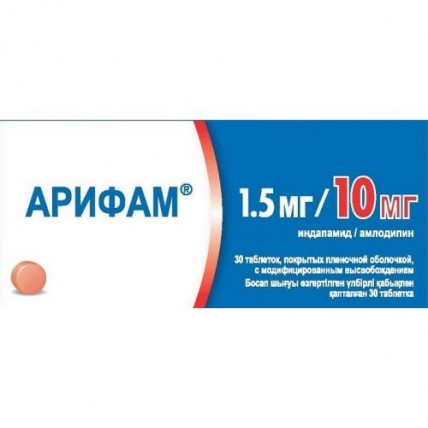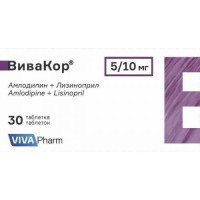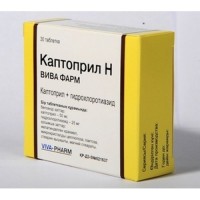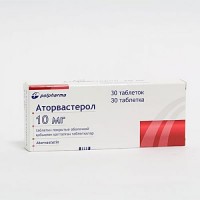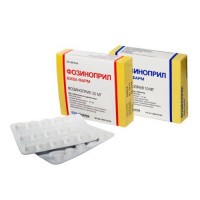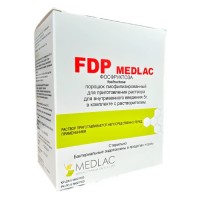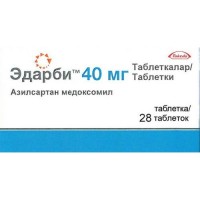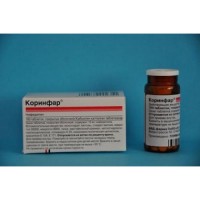Arif 1.5 mg / 10 mg (30 film-coated tablets) with modified release
- $30.60
Trade name
of Arifam®
the International unlicensed name
Is not present
the Dosage form
of the Tablet 1.5 mg, film coated with the modified release, / 5 mg and 1.5 mg / 10 mg
Structure
One tablet contains
active agent:
tablets of 1.5 mg / 5 mg: indapamid 1.5 mg and an amlodipina of the besilat of 6.935 mg, (5 mg of an amlodipin are equivalent)
tablets of 1.5 mg / 10 mg: an indapamida of 1.5 mg and an amlodipin of the besilat of 13.87 mg, (10 mg of an amlodipin are equivalent)
excipients: gipromelloza 4000, lactoses monohydrate, magnesium stearate, K 30 povidone, silicon dioxide colloidal anhydrous, calcium hydrophosphate dihydrate, cellulose microcrystalline, sodium of a kroskarmelloz, starch corn prezhelatinizirovanny
cover: giltserin, a gipermelloza, ferrous oxide red (E 172), a macrogoal 6000, magnesium stearate, the titan dioxide (E 171), the water purified
the Description
Two-layer tablets of round shape, film coated, white color with the engraved symbol on one party of a tablet (for a dosage of 1.5 mg / 5 mg),
Two-layer tablets of round shape, film coated, pink color, with the engraved symbol on one party of a tablet (for a dosage of 1.5 mg / 10 mg).
Pharmacotherapeutic group
Blockers of slow calcium channels. Blockers of slow calcium channels in a combination with diuretics. Amlodipin and diuretics.
ATX C08GA02 code
Pharmacological
Indapamid Pharmacokinetics properties:
Indapamid of 1.5 mg is provided by the slowed-down release which basis is the special matrix carrier providing gradual controlled release of an indapamid.
Absorption:
Released indapamid it is quickly and completely soaked up in digestive tract.
Meal slightly increases drug absorption time, without affecting at the same time completeness of absorption of active agent.
The maximum concentration in blood plasma is reached in 12 hours after intake of a single dose. At repeated methods of fluctuation of concentration of drug in blood plasma in an interval between administrations of drug smooth out. There is an individual variability of indicators of absorption of drug.
Distribution:
About 79% of drug contact proteins of blood plasma.
Elimination half-life makes 14-24 hours (on average, 18 hours).
Equilibrium concentration is reached in 7 days of administration of drug.
At repeated administration of drug its cumulation is not observed.
Removal:
Indapamid is brought in the form of inactive metabolites, generally by kidneys (70% of the entered dose) and through intestines (22%).
Amlodipin:
Amlodipin is provided by fast release.
Absorption, distribution, linking with proteins of plasma:
After oral administration of therapeutic doses amlodipin it is well soaked up, reaching the maximum concentration in blood in 6-12 hours after administration of drug. The absolute bioavailability is 64-80%. The volume of distribution is about 21 l/kg. In the researches in vitro it was shown that about 97.5% of the circulating amlodipin are connected with proteins of blood plasma.
Meal does not influence bioavailability of an amlodipin.
Biotransformation/removal
Final plasma elimination half-life of blood makes about 35-50 hours that allows to take the drug of 1 times a day. Amlodipin is actively metabolized in a liver with formation of inaktivny metabolites: 10% in not changed look, 60% of metabolites are removed with urine.
The pharmacodynamics
Indapamid belongs to sulfonamide derivatives with an indole ring and on pharmacological properties is close to thiazide diuretics which inhibit a reabsorption of ions of sodium in a cortical segment of a nephronic loop. At the same time discharge kidneys of ions of sodium, chlorine and to a lesser extent potassium ions and magnesium increases that is followed by increase in a diuresis and hypotensive effect.
Amlodipin - inhibitor of a stream of calcium ions of dihydropyridinic group (a blocker of slow calcium channels or the antagonist of calcium ions), it inhibits a transmembrane stream of calcium ions in cardiomyocytes and smooth muscle cells of a vascular wall.
The mechanism of hypotensive action of an amlodipin is caused by the direct weakening impact on smooth muscle cells of a vascular wall.
The antihypertensive activity of an indapamid is connected with improvement of elastic properties of large arteries, reduction of arteriolar and general peripheric vascular resistance.
Indapamid reduces a hypertrophy of a left ventricle.
Thiazide and tiazidopodobny diuretics at a certain dose reach the plateau of therapeutic effect while the frequency of side effects continues to increase. Therefore it is not necessary to increase a drug dose if the therapeutic effect is not reached.
In clinical trials of II and III phases when using an indapamid in the monotherapy mode in the doses which are not rendering the significant diuretic effect the 24-hour hypotensive effect was shown.
In short, the average duration and long-term researches with participation of patients with arterial hypertension it was shown that indapamid:
does not influence indicators of lipidic exchange: on the level of triglycerides, cholesterol of lipoproteins of low density and lipoproteins of high density,
does not influence indicators of exchange of carbohydrates, including at the patients with diabetes having hypertensia.
At patients with hypertensia the reception of a single dose of an amlodipin of 1 times a day provides clinically significant lowering of blood pressure both in a dorsal decubitus, and in a standing position within 24 hours. Due to the slow development of antihypertensive action the acute hypotension is not characteristic of introduction of an amlodipin.
Amlodipin does not cause any undesirable metabolic reactions, does not influence indicators of a lipidic profile, and can be applied at patients with the accompanying asthma, diabetes and gout.
Indications
- at treatment of essential hypertensia at the patients accepting indapamid and amlodipin in the same doses as fixed of a combination.
The route of administration and doses
is recommended to take the Drug in the morning to food, 1 times a day. It is necessary to swallow of a tablet entirely, without chewing, washing down with water.
The combined drug in the fixed doses is not suitable for initial therapy. If change of a dosage is required, the titration should be carried out with separate components.
Duration of a course of treatment is defined by the attending physician.
Side effects
Very often (& gt, 1/10), it is frequent (& gt, 1/100, & lt, 1/10), infrequently (& gt, 1/1000, & lt, 1/100), is rare (& gt, 1/10000, & lt, 1/1000), is very rare (& gt, 1/10000), frequency is not established (on the basis of the available data it is not possible to carry out the development frequency assessment).
Often
- drowsiness
- dizziness, a headache
- hyperaemia
- an abdominal pain, nausea
- makulopapulezny rash
- a swelling of an ankle joint
- swelled
Infrequently
- insomnia
- change of mood (including uneasiness)
- a depression, a tremor, a dysgeusia, a hypesthesia
- a disorder of vision (including a diplopia)
- tinnitus, rhinitis
- a cardiopalmus
- short wind
- vomiting, dyspepsia, change of a rhythm of defecation (including diarrhea and a constipation)
- an arthralgia, myalgia, muscular spasms, a dorsodynia
- urination disturbance, the night increased urination frequency
- a polyuria
- impotence
- a gynecomastia
- a stethalgia, an asthenia, feeling of discomfort, increase in body weight, lowering of body weight
Is rare
- confusion of consciousness
- paresthesia
- vertigo
- dryness in a mouth, a constipation
- a purpura, an alopecia, discoloration of skin, an itching, rash, a dieback
- a hyperhidrosis
- fatigue
Very seldom
- a leykotsitopeniya, a tombotsitopeniya, aplastic anemia, hemolytic anemia
- an agranulocytosis
- allergic reactions
- a hypopotassemia, a hyperglycemia, a hypercalcemia
- a hypertension, hypotension
- peripheral neuropathy
- a myocardial infarction
- arrhythmia (including bradycardia, ventricular tachycardia and an atrial fibrillation)
- a vasculitis
- cough
- gastritis, pancreatitis, hepatitis, jaundice, increase in level of enzymes of a liver
- an abnormal liver function
- a hyperplasia of gums
- a Quincke's disease, a small tortoiseshell, a toxic epidermal necrolysis, Stephens-Johnson's syndrome, a multiformny erythema, exfoliative dermatitis, a Quincke's edema
- photosensitivity
- the renal failure
Frequency is not established
- a hyponatremia with a gipovoliyemiya
- a syncope
- shortsightedness, illegibility of sight, decrease in visual acuity
- tachycardia
- hepatitis, increase in level of liver enzymes
- hepatic encephalopathy against the background of a liver failure
- possible aggravation of the available sharp disseminate lupus erythematosus
- the extended QT interval on the electrocardiogram
- increase in level of glucose and uric acid in blood during therapy
of the Contraindication
hypersensitivity to active agents, to other sulfonamides, to derivatives of dihydropyridine or any of excipients
a heavy renal failure (the clearance of creatinine is lower than 30 ml/min.)
hepatic encephalopathy or a heavy liver failure
a hypopotassemia
pregnancy and the period of a lactation
a severe form of hypotension
shock (including cardiogenic shock)
obstruction of an output path of a left ventricle (stenosis of the aortal valve)
heart failure after an acute myocardial infarction
intolerance of a galactose, deficiency of Lappa lactase or a syndrome glucose
of galaktozny malabsorption
Medicinal interactions
of Lities
the Increased lithium level in plasma with overdose symptoms, as well as in a case with a saltless diet (reduction of removal of lithium with urine). However if use of diuretics is necessary, it is necessary to adjust a dose and to carry out careful monitoring of level of lithium in plasma.
The drugs causing bidirectional tachycardia:
antiarrhytmic drugs of the class Ia (quinidine, hydroquinidine, Disopyramidum),
antiarrhytmic drugs of class III (Amiodaronum, sotalol, dofetilid, ibutilid),
some antipsychotic drugs:
fenotiazina (Chlorpromazinum, tsiamemazin, levomepromazinum, thioridazine, trifluoperazin), benzamides (amisulprid, Sulpiridum, sultoprid, tiaprid),
phenyl propyl ketones (Droperidolum, haloperidol),
others: bepridit, tsizaprid, difemanit, erythromycin in/in, galofantrin, mizolastin, pentamidine, sparfloksatsin, moxifloxacin, Vincaminum in / century.
The increased risk of developing of ventricular arrhythmias, in particular bidirectional tachycardia (the hypopotassemia is risk factor).
Before therapy it is necessary to be convinced by this combination of lack of a hypopotassemia and to carry out adjustment, in case of need. Clinical monitoring, monitoring of level of electrolytes in plasma and ECG monitoring.
The patients suffering from a hypopotassemia should appoint the drugs which are not causing bidirectional tachycardia.
NPVS (system route of administration), including selection TsOG-2 inhibitors, high doses of aspirin ( of 3 g/day):
Possible decrease in hypotensive effect of an indapamid.
Risk of an acute renal failure at the patients having organism dehydration (the lowered glomerular filtration). To hydrate the patient, at the beginning of therapy to carry out monitoring of function of kidneys.
Inhibitors angiotensin-reformative enzyme (ARE):
In case therapy by APF inhibitors begins against the background of the existing sodium depletion (especially at the patients having a renal artery stenosis), there is a risk of developing of sudden hypotension and/or acute renal failure.
In hypertensia if the previous therapy by diuretic caused a sodium depletion, it is necessary:
- or to stop intake of diuretic in 3 days prior to therapy by APF inhibitor, and then to start intake of gipokaliyemichesky diuretic over again if it is necessary,
- or to appoint a low initial dose of APF inhibitor, and then to gradually raise it.
In stagnant heart failure, intake of APF inhibitor should be begun with very low dose, whenever possible after a preliminary dose decline of the accompanying gipokaliyemichesky diuretic.
In all cases, within the first weeks of therapy it is necessary to carry out by APF inhibitor monitoring of function of kidneys (creatinine level in plasma).
Other drugs causing a hypopotassemia: Amphotericinum B (in / c), glyuko- and mineralokortikoida, tetrakozaktid, the stimulating depletive:
The increased risk of emergence of a hypopotassemia (additive effect).
Monitoring of level of potassium in plasma and its adjustment, in case of need. It is especially important to remember it at the accompanying therapy by drugs on the basis of a digitalis. To apply not stimulating depletive.
Drugs on the basis of a digitalis:
The hypopotassemia is the contributing factor to toxic effect of a digitalis.
To carry out monitoring of level of potassium in plasma, ECG monitoring and, in case of need, to correct therapy.
Baclofenum:
Increase in hypotensive effect.
To hydrate the patient, at the beginning of therapy to carry out monitoring of function of kidneys.
The combinations of medicines requiring attention:
Kaliysberegayushchy diuretics (amiloride, Spironolactonum, Triamterenum):
While reasonable combinations are effective at some patients, the risk of emergence of a hypopotassemia (especially at patients with a renal failure or diabetes) or hyperpotassemias nevertheless exists. It is necessary to carry out monitoring of level of potassium in plasma, ECG monitoring and, in case of need, to reconsider therapy.
Metformin:
The increased risk of development of the laktatsidoz caused by metformin because of a possible functional renal failure against the background of intake of diuretics and especially loopback diuretics. It is not necessary to appoint metformin if creatinine level in plasma exceeds 15 mg/l (135 µmol/l) at men and women have 12 mg/l (110 µmol/l).
The iodated contrast means:
In case of dehydration of the organism caused by intake of diuretics there is an increased risk of developing an acute renal failure, in particular, when high doses of the iodated contrast means are used.
It is necessary to provide necessary rehydration of the patient before administration of the iodated drug.
Imipraminopodobny antidepressants, neuroleptics:
Strengthening of hypotensive effect and increase in risk of orthostatic hypotension (additive effect).
Calcium (salts):
Risk of development of a hypercalcemia as a result of the lowered removal of calcium with urine.
Cyclosporine, takrolimus:
Risk of increase in level of creatinine in plasma without change of level of the cyclosporine which is in system blood circulation, even in the absence of a water/sodium depletion.
Corticosteroids, tetrakozaktid:
The lowered hypotensive effect (the water/sodium delay connected with reception of corticosteroids).
Connected with amlodipiny:
Dantrolen (infusion): against the background of administration of verapamil and a dantrolen the cases of fibrillation of ventricles and cardiovascular insufficiency with a lethal outcome connected with a hyperpotassemia were intravenously noted. Due to the risk of a hyperpotassemia it is recommended to avoid the combined use of blockers of calcium channels, such as amlodipin, at the patients subject to a malignant hyper pyrexia, and at therapy of a malignant hyper pyrexia.
Reception of an amlodipin with grapefruit or grapefruit juice is not recommended as the bioavailability can increase at some patients, leading to strengthening of effect of pressure decrease.
CYP3A4 inhibitors: combined use of an amlodipin with strong or moderate inhibitors of an isoenzyme CYP3A4 (protease inhibitors, azolny fungicides, macroleads, such as erythromycin or klaritromitsin, verapamil or diltiazem) can lead to significant increase in plasma concentration of an amlodipin. Clinical expression of these variations of pharmacokinetics can be more obvious at elderly patients. Thus, clinical observation and selection of a dose can be required.
Inductors CYP3A4: there are no available data on influence of inductors of an isoenzyme of CYP3A4 on amlodipin. The combined use of inductors of an isoenzyme of CYP3A4 (for example, the rifampicin, a St. John's wort which is made a hole) can cause decrease in concentration of an amlodipin in plasma. At use of an amlodipin it is necessary to be careful with inductors of an isoenzyme CYP3A4.
Impact of an amlodipin on other medicines
Effect of pressure decrease of an amlodipin supplements the effect of lowering of blood pressure caused by other medicines with hypotensive properties.
In clinical trials of interaction of medicines amlodipin did not find influence on pharmacokinetics of an atorvastatin, digoxin, warfarin or cyclosporine.
Simvastatin: the combined use of reusable doses of 10 mg of an amlodipin and 80 mg of a simvastatin led to increase in exposure of a simvastatin by 77% in comparison with use of one simvastatin. The day dose of a simvastatin at the patients accepting amlodipin should not exceed 20 mg.
Special instructions
Hepatic encephalopathy
At disturbance of hepatic function thiazide and related diuretics can cause hepatic encephalopathy, especially in case of an electrolytic imbalance. Owing to existence of an indapamid as a part of drug, Arifam's reception should be stopped immediately if there is such state.
Photosensitivity
It was reported about emergence of reactions of photosensitivity against the background of reception of tiazid and related diuretics. If during therapy reactions of photosensitivity arise drug, treatment is recommended to be stopped. If repeated prescribing of diuretic is considered necessary, recommended to avoid influence of solar or artificial UV rays.
Hypertensive crisis
Safety and efficiency of an amlodipin in hypertensive crisis were not established.
Water and electrolytic balance
• Sodium level in blood plasma
Should be checked before therapy and it is regular during therapy. Any therapy by diuretic can cause a hyponatremia, sometimes with very serious consequences. Sharp decrease in level of sodium in plasma at an initial stage can be asymptomatic therefore it is important to carry out regular monitoring of level of sodium in plasma. At the elderly patients and patients having cirrhosis, monitoring should be carried out even more often.
• Potassium level in
potassium Depletion blood plasma at a hypopotassemia is the main risk of use of tiazid and related diuretics. At some populations of patients of the increased risk as, for example, at elderly patients, the patients eating defectively and/or taking several medicines, patients with cirrhosis, hypostasis and ascites, coronary heart disease and heart failure it is necessary to prevent risk of emergence of a hypopotassemia (& lt, 3.4 mmol/l). In this case the hypopotassemia increases cardiotoxicity of drugs on the basis of a digitalis and risk of developing of arrhythmias.
Patients with the extended QT interval, both inborn, and iatrogenic, also treat group of the increased risk. So, a hypopotassemia as well as bradycardia, are the contributing factor to developing of heavy arrhythmia, in particular, of potentially lethal bidirectional tachycardia.
In all above-stated situations more frequent carrying out monitoring of level of potassium in blood plasma is required. The first measurement of level of potassium in blood plasma should be taken within the first week after an initiation of treatment.
Detection of a hypopotassemia demands acceptance of remedial measures.
• Calcium level in blood plasma
of Tiazida and related diuretics can reduce removal of calcium with urine and cause easy and tranzitorny increase in level of calcium in blood plasma. The expressed hyperpotassemia can be result of earlier not identified hyperparathyreosis.
Therapy by drug it is necessary to stop and conduct a research of function of an epithelial body.
Glucose level in blood
Owing to existence of an indapamid as a part of drug, at the patients having diabetes it is important to carry out monitoring of level of glucose to blood, especially at the accompanying hypopotassemia.
Heart failure
When performing therapy at patients with heart failure it is necessary to observe extra care. In long placebo - a controlled research at patients with an acute heart failure (III and IV functional class on classification of NYHA) the number of cases of edematization of lungs was higher in group of the patients accepting amlodipin than in group of the patients accepting placebo. Blockers of calcium channels, including amlodipin, patients should appoint with care with stagnant heart failure as they increase risk of cardiovascular complications and lethal outcomes.
Function of kidneys
of Tiazida and related diuretics are completely effective only for patients with normal function of a liver or with the minimum disturbances (creatinine level in plasma lower than the level about 25 mg/l, i.e. the adult patient has 220 µmol/l). At elderly patients the creatinine level in plasma should be corrected depending on age, weight and a floor.
The hypovolemia caused by loss of water and sodium as a result of intake of diuretic in an initiation of treatment causes reduction in the rate of glomerular filtration. It can lead to increase in level of urea in blood and creatinine in plasma. This tranzitorny functional renal failure has no consequences at patients with normal function of kidneys, however can aggravate already existing renal failure.
At patients with a renal failure amlodipin it can be applied in normal doses. Changes of concentration of an amlodipin in blood plasma do not correlate with the degree of manifestation of a renal failure. Amlodipin is not brought by dialysis.
At patients with a renal failure of a dose of Arifama® have to correspond to doses of its components accepted separately.
Level of uric acid
Owing to existence of an indapamid as a part of drug, at patients with the increased level of uric acid can be observed a tendency to increase of attacks of gout.
Function of a liver
Elimination half-life of an amlodipin increases, and values of indicators of AUC are higher at patients from the liver broken by function, recommendations about a dosage were not established. Therefore at such patients the therapy amlodipiny should be begun with the lowest level of range of doses, being careful both at the beginning of therapy, and at increase in a dose.
When prescribing drug the patients should be careful with easy and moderate degree of a liver failure.
Elderly patients
Elderly patients can accept Arifam® depending on a condition of their renal function.
Children's age
Safety and efficiency of use for children are not established.
The feature of influence of medicine on ability to run the vehicle and potentially dangerous mechanisms
Is recommended to be careful at control of motor transport, especially in an initiation of treatment.
The overdose
of Information on overdose by the drug Arifama is not present. Symptoms of acute poisoning mostly are shown in the form of disturbances of water and electrolytic balance (hyponatremia, a hypopotassemia). Developing of nausea, vomiting, arterial hypotension, spasms, vertigo, drowsiness, confusion of consciousness, a polyuria or an oliguria is clinically possible that can lead to an anury (owing to a hypovolemia). On the basis of the available data it is possible to assume that reception of very high doses can be associated with an excess peripheral vazodilatation and probable developing of reflex tachycardia. It was reported about expressed, perhaps, to long system hypotension that led to shock with a lethal outcome.
Treatment. Measures of first aid include fast removal of the accepted substance by gastric lavage and/or uses of activated carbon with the subsequent normalization of water and electrolytic balance in the conditions of a hospital. Clinically significant hypotension caused by overdose of an amlodipin demands the active cardiovascular help, including frequent monitoring of function of heart and respiratory function, a raising of the lower extremities and also control of OCK and urination. Purpose of a vasoconstrictor can be useful to restoration of a tone of vessels and the ABP in the absence of contraindications to use. Administration of calcium of a gluconate will probably help with elimination of consequences of blockade of calcium channels. In certain cases there can be useful a gastric lavage. Intake of activated carbon during 2 h after use of an amlodipin in a dose of 10 mg reduces the speed of absorption of the last. As amlodipin has the high level of linking with proteins, carrying out a hemodialysis will probably not yield result.
The form of release and packing
On 15 tablets place in blister strip packaging.
On the 2nd blister strip packagings together with the instruction for medical use in the state and Russian languages put in a pack cardboard.
To Store storage conditions at a temperature not above 30 °C.
To store out of children's reach!
2 years
not to apply a period of storage after the expiration date specified on packing.
Prescription status
According to the prescription
Les Laboratoires Servier Industrie Producer, France
to Develop
of Arifam®
the International unlicensed name
Is not present
the Dosage form
of the Tablet 1.5 mg, film coated with the modified release, / 5 mg and 1.5 mg / 10 mg
Structure
One tablet contains
active agent:
tablets of 1.5 mg / 5 mg: indapamid 1.5 mg and an amlodipina of the besilat of 6.935 mg, (5 mg of an amlodipin are equivalent)
tablets of 1.5 mg / 10 mg: an indapamida of 1.5 mg and an amlodipin of the besilat of 13.87 mg, (10 mg of an amlodipin are equivalent)
excipients: gipromelloza 4000, lactoses monohydrate, magnesium stearate, K 30 povidone, silicon dioxide colloidal anhydrous, calcium hydrophosphate dihydrate, cellulose microcrystalline, sodium of a kroskarmelloz, starch corn prezhelatinizirovanny
cover: giltserin, a gipermelloza, ferrous oxide red (E 172), a macrogoal 6000, magnesium stearate, the titan dioxide (E 171), the water purified
the Description
Two-layer tablets of round shape, film coated, white color with the engraved symbol on one party of a tablet (for a dosage of 1.5 mg / 5 mg),
Two-layer tablets of round shape, film coated, pink color, with the engraved symbol on one party of a tablet (for a dosage of 1.5 mg / 10 mg).
Pharmacotherapeutic group
Blockers of slow calcium channels. Blockers of slow calcium channels in a combination with diuretics. Amlodipin and diuretics.
ATX C08GA02 code
Pharmacological
Indapamid Pharmacokinetics properties:
Indapamid of 1.5 mg is provided by the slowed-down release which basis is the special matrix carrier providing gradual controlled release of an indapamid.
Absorption:
Released indapamid it is quickly and completely soaked up in digestive tract.
Meal slightly increases drug absorption time, without affecting at the same time completeness of absorption of active agent.
The maximum concentration in blood plasma is reached in 12 hours after intake of a single dose. At repeated methods of fluctuation of concentration of drug in blood plasma in an interval between administrations of drug smooth out. There is an individual variability of indicators of absorption of drug.
Distribution:
About 79% of drug contact proteins of blood plasma.
Elimination half-life makes 14-24 hours (on average, 18 hours).
Equilibrium concentration is reached in 7 days of administration of drug.
At repeated administration of drug its cumulation is not observed.
Removal:
Indapamid is brought in the form of inactive metabolites, generally by kidneys (70% of the entered dose) and through intestines (22%).
Amlodipin:
Amlodipin is provided by fast release.
Absorption, distribution, linking with proteins of plasma:
After oral administration of therapeutic doses amlodipin it is well soaked up, reaching the maximum concentration in blood in 6-12 hours after administration of drug. The absolute bioavailability is 64-80%. The volume of distribution is about 21 l/kg. In the researches in vitro it was shown that about 97.5% of the circulating amlodipin are connected with proteins of blood plasma.
Meal does not influence bioavailability of an amlodipin.
Biotransformation/removal
Final plasma elimination half-life of blood makes about 35-50 hours that allows to take the drug of 1 times a day. Amlodipin is actively metabolized in a liver with formation of inaktivny metabolites: 10% in not changed look, 60% of metabolites are removed with urine.
The pharmacodynamics
Indapamid belongs to sulfonamide derivatives with an indole ring and on pharmacological properties is close to thiazide diuretics which inhibit a reabsorption of ions of sodium in a cortical segment of a nephronic loop. At the same time discharge kidneys of ions of sodium, chlorine and to a lesser extent potassium ions and magnesium increases that is followed by increase in a diuresis and hypotensive effect.
Amlodipin - inhibitor of a stream of calcium ions of dihydropyridinic group (a blocker of slow calcium channels or the antagonist of calcium ions), it inhibits a transmembrane stream of calcium ions in cardiomyocytes and smooth muscle cells of a vascular wall.
The mechanism of hypotensive action of an amlodipin is caused by the direct weakening impact on smooth muscle cells of a vascular wall.
The antihypertensive activity of an indapamid is connected with improvement of elastic properties of large arteries, reduction of arteriolar and general peripheric vascular resistance.
Indapamid reduces a hypertrophy of a left ventricle.
Thiazide and tiazidopodobny diuretics at a certain dose reach the plateau of therapeutic effect while the frequency of side effects continues to increase. Therefore it is not necessary to increase a drug dose if the therapeutic effect is not reached.
In clinical trials of II and III phases when using an indapamid in the monotherapy mode in the doses which are not rendering the significant diuretic effect the 24-hour hypotensive effect was shown.
In short, the average duration and long-term researches with participation of patients with arterial hypertension it was shown that indapamid:
does not influence indicators of lipidic exchange: on the level of triglycerides, cholesterol of lipoproteins of low density and lipoproteins of high density,
does not influence indicators of exchange of carbohydrates, including at the patients with diabetes having hypertensia.
At patients with hypertensia the reception of a single dose of an amlodipin of 1 times a day provides clinically significant lowering of blood pressure both in a dorsal decubitus, and in a standing position within 24 hours. Due to the slow development of antihypertensive action the acute hypotension is not characteristic of introduction of an amlodipin.
Amlodipin does not cause any undesirable metabolic reactions, does not influence indicators of a lipidic profile, and can be applied at patients with the accompanying asthma, diabetes and gout.
Indications
- at treatment of essential hypertensia at the patients accepting indapamid and amlodipin in the same doses as fixed of a combination.
The route of administration and doses
is recommended to take the Drug in the morning to food, 1 times a day. It is necessary to swallow of a tablet entirely, without chewing, washing down with water.
The combined drug in the fixed doses is not suitable for initial therapy. If change of a dosage is required, the titration should be carried out with separate components.
Duration of a course of treatment is defined by the attending physician.
Side effects
Very often (& gt, 1/10), it is frequent (& gt, 1/100, & lt, 1/10), infrequently (& gt, 1/1000, & lt, 1/100), is rare (& gt, 1/10000, & lt, 1/1000), is very rare (& gt, 1/10000), frequency is not established (on the basis of the available data it is not possible to carry out the development frequency assessment).
Often
- drowsiness
- dizziness, a headache
- hyperaemia
- an abdominal pain, nausea
- makulopapulezny rash
- a swelling of an ankle joint
- swelled
Infrequently
- insomnia
- change of mood (including uneasiness)
- a depression, a tremor, a dysgeusia, a hypesthesia
- a disorder of vision (including a diplopia)
- tinnitus, rhinitis
- a cardiopalmus
- short wind
- vomiting, dyspepsia, change of a rhythm of defecation (including diarrhea and a constipation)
- an arthralgia, myalgia, muscular spasms, a dorsodynia
- urination disturbance, the night increased urination frequency
- a polyuria
- impotence
- a gynecomastia
- a stethalgia, an asthenia, feeling of discomfort, increase in body weight, lowering of body weight
Is rare
- confusion of consciousness
- paresthesia
- vertigo
- dryness in a mouth, a constipation
- a purpura, an alopecia, discoloration of skin, an itching, rash, a dieback
- a hyperhidrosis
- fatigue
Very seldom
- a leykotsitopeniya, a tombotsitopeniya, aplastic anemia, hemolytic anemia
- an agranulocytosis
- allergic reactions
- a hypopotassemia, a hyperglycemia, a hypercalcemia
- a hypertension, hypotension
- peripheral neuropathy
- a myocardial infarction
- arrhythmia (including bradycardia, ventricular tachycardia and an atrial fibrillation)
- a vasculitis
- cough
- gastritis, pancreatitis, hepatitis, jaundice, increase in level of enzymes of a liver
- an abnormal liver function
- a hyperplasia of gums
- a Quincke's disease, a small tortoiseshell, a toxic epidermal necrolysis, Stephens-Johnson's syndrome, a multiformny erythema, exfoliative dermatitis, a Quincke's edema
- photosensitivity
- the renal failure
Frequency is not established
- a hyponatremia with a gipovoliyemiya
- a syncope
- shortsightedness, illegibility of sight, decrease in visual acuity
- tachycardia
- hepatitis, increase in level of liver enzymes
- hepatic encephalopathy against the background of a liver failure
- possible aggravation of the available sharp disseminate lupus erythematosus
- the extended QT interval on the electrocardiogram
- increase in level of glucose and uric acid in blood during therapy
of the Contraindication
hypersensitivity to active agents, to other sulfonamides, to derivatives of dihydropyridine or any of excipients
a heavy renal failure (the clearance of creatinine is lower than 30 ml/min.)
hepatic encephalopathy or a heavy liver failure
a hypopotassemia
pregnancy and the period of a lactation
a severe form of hypotension
shock (including cardiogenic shock)
obstruction of an output path of a left ventricle (stenosis of the aortal valve)
heart failure after an acute myocardial infarction
intolerance of a galactose, deficiency of Lappa lactase or a syndrome glucose
of galaktozny malabsorption
Medicinal interactions
of Lities
the Increased lithium level in plasma with overdose symptoms, as well as in a case with a saltless diet (reduction of removal of lithium with urine). However if use of diuretics is necessary, it is necessary to adjust a dose and to carry out careful monitoring of level of lithium in plasma.
The drugs causing bidirectional tachycardia:
antiarrhytmic drugs of the class Ia (quinidine, hydroquinidine, Disopyramidum),
antiarrhytmic drugs of class III (Amiodaronum, sotalol, dofetilid, ibutilid),
some antipsychotic drugs:
fenotiazina (Chlorpromazinum, tsiamemazin, levomepromazinum, thioridazine, trifluoperazin), benzamides (amisulprid, Sulpiridum, sultoprid, tiaprid),
phenyl propyl ketones (Droperidolum, haloperidol),
others: bepridit, tsizaprid, difemanit, erythromycin in/in, galofantrin, mizolastin, pentamidine, sparfloksatsin, moxifloxacin, Vincaminum in / century.
The increased risk of developing of ventricular arrhythmias, in particular bidirectional tachycardia (the hypopotassemia is risk factor).
Before therapy it is necessary to be convinced by this combination of lack of a hypopotassemia and to carry out adjustment, in case of need. Clinical monitoring, monitoring of level of electrolytes in plasma and ECG monitoring.
The patients suffering from a hypopotassemia should appoint the drugs which are not causing bidirectional tachycardia.
NPVS (system route of administration), including selection TsOG-2 inhibitors, high doses of aspirin ( of 3 g/day):
Possible decrease in hypotensive effect of an indapamid.
Risk of an acute renal failure at the patients having organism dehydration (the lowered glomerular filtration). To hydrate the patient, at the beginning of therapy to carry out monitoring of function of kidneys.
Inhibitors angiotensin-reformative enzyme (ARE):
In case therapy by APF inhibitors begins against the background of the existing sodium depletion (especially at the patients having a renal artery stenosis), there is a risk of developing of sudden hypotension and/or acute renal failure.
In hypertensia if the previous therapy by diuretic caused a sodium depletion, it is necessary:
- or to stop intake of diuretic in 3 days prior to therapy by APF inhibitor, and then to start intake of gipokaliyemichesky diuretic over again if it is necessary,
- or to appoint a low initial dose of APF inhibitor, and then to gradually raise it.
In stagnant heart failure, intake of APF inhibitor should be begun with very low dose, whenever possible after a preliminary dose decline of the accompanying gipokaliyemichesky diuretic.
In all cases, within the first weeks of therapy it is necessary to carry out by APF inhibitor monitoring of function of kidneys (creatinine level in plasma).
Other drugs causing a hypopotassemia: Amphotericinum B (in / c), glyuko- and mineralokortikoida, tetrakozaktid, the stimulating depletive:
The increased risk of emergence of a hypopotassemia (additive effect).
Monitoring of level of potassium in plasma and its adjustment, in case of need. It is especially important to remember it at the accompanying therapy by drugs on the basis of a digitalis. To apply not stimulating depletive.
Drugs on the basis of a digitalis:
The hypopotassemia is the contributing factor to toxic effect of a digitalis.
To carry out monitoring of level of potassium in plasma, ECG monitoring and, in case of need, to correct therapy.
Baclofenum:
Increase in hypotensive effect.
To hydrate the patient, at the beginning of therapy to carry out monitoring of function of kidneys.
The combinations of medicines requiring attention:
Kaliysberegayushchy diuretics (amiloride, Spironolactonum, Triamterenum):
While reasonable combinations are effective at some patients, the risk of emergence of a hypopotassemia (especially at patients with a renal failure or diabetes) or hyperpotassemias nevertheless exists. It is necessary to carry out monitoring of level of potassium in plasma, ECG monitoring and, in case of need, to reconsider therapy.
Metformin:
The increased risk of development of the laktatsidoz caused by metformin because of a possible functional renal failure against the background of intake of diuretics and especially loopback diuretics. It is not necessary to appoint metformin if creatinine level in plasma exceeds 15 mg/l (135 µmol/l) at men and women have 12 mg/l (110 µmol/l).
The iodated contrast means:
In case of dehydration of the organism caused by intake of diuretics there is an increased risk of developing an acute renal failure, in particular, when high doses of the iodated contrast means are used.
It is necessary to provide necessary rehydration of the patient before administration of the iodated drug.
Imipraminopodobny antidepressants, neuroleptics:
Strengthening of hypotensive effect and increase in risk of orthostatic hypotension (additive effect).
Calcium (salts):
Risk of development of a hypercalcemia as a result of the lowered removal of calcium with urine.
Cyclosporine, takrolimus:
Risk of increase in level of creatinine in plasma without change of level of the cyclosporine which is in system blood circulation, even in the absence of a water/sodium depletion.
Corticosteroids, tetrakozaktid:
The lowered hypotensive effect (the water/sodium delay connected with reception of corticosteroids).
Connected with amlodipiny:
Dantrolen (infusion): against the background of administration of verapamil and a dantrolen the cases of fibrillation of ventricles and cardiovascular insufficiency with a lethal outcome connected with a hyperpotassemia were intravenously noted. Due to the risk of a hyperpotassemia it is recommended to avoid the combined use of blockers of calcium channels, such as amlodipin, at the patients subject to a malignant hyper pyrexia, and at therapy of a malignant hyper pyrexia.
Reception of an amlodipin with grapefruit or grapefruit juice is not recommended as the bioavailability can increase at some patients, leading to strengthening of effect of pressure decrease.
CYP3A4 inhibitors: combined use of an amlodipin with strong or moderate inhibitors of an isoenzyme CYP3A4 (protease inhibitors, azolny fungicides, macroleads, such as erythromycin or klaritromitsin, verapamil or diltiazem) can lead to significant increase in plasma concentration of an amlodipin. Clinical expression of these variations of pharmacokinetics can be more obvious at elderly patients. Thus, clinical observation and selection of a dose can be required.
Inductors CYP3A4: there are no available data on influence of inductors of an isoenzyme of CYP3A4 on amlodipin. The combined use of inductors of an isoenzyme of CYP3A4 (for example, the rifampicin, a St. John's wort which is made a hole) can cause decrease in concentration of an amlodipin in plasma. At use of an amlodipin it is necessary to be careful with inductors of an isoenzyme CYP3A4.
Impact of an amlodipin on other medicines
Effect of pressure decrease of an amlodipin supplements the effect of lowering of blood pressure caused by other medicines with hypotensive properties.
In clinical trials of interaction of medicines amlodipin did not find influence on pharmacokinetics of an atorvastatin, digoxin, warfarin or cyclosporine.
Simvastatin: the combined use of reusable doses of 10 mg of an amlodipin and 80 mg of a simvastatin led to increase in exposure of a simvastatin by 77% in comparison with use of one simvastatin. The day dose of a simvastatin at the patients accepting amlodipin should not exceed 20 mg.
Special instructions
Hepatic encephalopathy
At disturbance of hepatic function thiazide and related diuretics can cause hepatic encephalopathy, especially in case of an electrolytic imbalance. Owing to existence of an indapamid as a part of drug, Arifam's reception should be stopped immediately if there is such state.
Photosensitivity
It was reported about emergence of reactions of photosensitivity against the background of reception of tiazid and related diuretics. If during therapy reactions of photosensitivity arise drug, treatment is recommended to be stopped. If repeated prescribing of diuretic is considered necessary, recommended to avoid influence of solar or artificial UV rays.
Hypertensive crisis
Safety and efficiency of an amlodipin in hypertensive crisis were not established.
Water and electrolytic balance
• Sodium level in blood plasma
Should be checked before therapy and it is regular during therapy. Any therapy by diuretic can cause a hyponatremia, sometimes with very serious consequences. Sharp decrease in level of sodium in plasma at an initial stage can be asymptomatic therefore it is important to carry out regular monitoring of level of sodium in plasma. At the elderly patients and patients having cirrhosis, monitoring should be carried out even more often.
• Potassium level in
potassium Depletion blood plasma at a hypopotassemia is the main risk of use of tiazid and related diuretics. At some populations of patients of the increased risk as, for example, at elderly patients, the patients eating defectively and/or taking several medicines, patients with cirrhosis, hypostasis and ascites, coronary heart disease and heart failure it is necessary to prevent risk of emergence of a hypopotassemia (& lt, 3.4 mmol/l). In this case the hypopotassemia increases cardiotoxicity of drugs on the basis of a digitalis and risk of developing of arrhythmias.
Patients with the extended QT interval, both inborn, and iatrogenic, also treat group of the increased risk. So, a hypopotassemia as well as bradycardia, are the contributing factor to developing of heavy arrhythmia, in particular, of potentially lethal bidirectional tachycardia.
In all above-stated situations more frequent carrying out monitoring of level of potassium in blood plasma is required. The first measurement of level of potassium in blood plasma should be taken within the first week after an initiation of treatment.
Detection of a hypopotassemia demands acceptance of remedial measures.
• Calcium level in blood plasma
of Tiazida and related diuretics can reduce removal of calcium with urine and cause easy and tranzitorny increase in level of calcium in blood plasma. The expressed hyperpotassemia can be result of earlier not identified hyperparathyreosis.
Therapy by drug it is necessary to stop and conduct a research of function of an epithelial body.
Glucose level in blood
Owing to existence of an indapamid as a part of drug, at the patients having diabetes it is important to carry out monitoring of level of glucose to blood, especially at the accompanying hypopotassemia.
Heart failure
When performing therapy at patients with heart failure it is necessary to observe extra care. In long placebo - a controlled research at patients with an acute heart failure (III and IV functional class on classification of NYHA) the number of cases of edematization of lungs was higher in group of the patients accepting amlodipin than in group of the patients accepting placebo. Blockers of calcium channels, including amlodipin, patients should appoint with care with stagnant heart failure as they increase risk of cardiovascular complications and lethal outcomes.
Function of kidneys
of Tiazida and related diuretics are completely effective only for patients with normal function of a liver or with the minimum disturbances (creatinine level in plasma lower than the level about 25 mg/l, i.e. the adult patient has 220 µmol/l). At elderly patients the creatinine level in plasma should be corrected depending on age, weight and a floor.
The hypovolemia caused by loss of water and sodium as a result of intake of diuretic in an initiation of treatment causes reduction in the rate of glomerular filtration. It can lead to increase in level of urea in blood and creatinine in plasma. This tranzitorny functional renal failure has no consequences at patients with normal function of kidneys, however can aggravate already existing renal failure.
At patients with a renal failure amlodipin it can be applied in normal doses. Changes of concentration of an amlodipin in blood plasma do not correlate with the degree of manifestation of a renal failure. Amlodipin is not brought by dialysis.
At patients with a renal failure of a dose of Arifama® have to correspond to doses of its components accepted separately.
Level of uric acid
Owing to existence of an indapamid as a part of drug, at patients with the increased level of uric acid can be observed a tendency to increase of attacks of gout.
Function of a liver
Elimination half-life of an amlodipin increases, and values of indicators of AUC are higher at patients from the liver broken by function, recommendations about a dosage were not established. Therefore at such patients the therapy amlodipiny should be begun with the lowest level of range of doses, being careful both at the beginning of therapy, and at increase in a dose.
When prescribing drug the patients should be careful with easy and moderate degree of a liver failure.
Elderly patients
Elderly patients can accept Arifam® depending on a condition of their renal function.
Children's age
Safety and efficiency of use for children are not established.
The feature of influence of medicine on ability to run the vehicle and potentially dangerous mechanisms
Is recommended to be careful at control of motor transport, especially in an initiation of treatment.
The overdose
of Information on overdose by the drug Arifama is not present. Symptoms of acute poisoning mostly are shown in the form of disturbances of water and electrolytic balance (hyponatremia, a hypopotassemia). Developing of nausea, vomiting, arterial hypotension, spasms, vertigo, drowsiness, confusion of consciousness, a polyuria or an oliguria is clinically possible that can lead to an anury (owing to a hypovolemia). On the basis of the available data it is possible to assume that reception of very high doses can be associated with an excess peripheral vazodilatation and probable developing of reflex tachycardia. It was reported about expressed, perhaps, to long system hypotension that led to shock with a lethal outcome.
Treatment. Measures of first aid include fast removal of the accepted substance by gastric lavage and/or uses of activated carbon with the subsequent normalization of water and electrolytic balance in the conditions of a hospital. Clinically significant hypotension caused by overdose of an amlodipin demands the active cardiovascular help, including frequent monitoring of function of heart and respiratory function, a raising of the lower extremities and also control of OCK and urination. Purpose of a vasoconstrictor can be useful to restoration of a tone of vessels and the ABP in the absence of contraindications to use. Administration of calcium of a gluconate will probably help with elimination of consequences of blockade of calcium channels. In certain cases there can be useful a gastric lavage. Intake of activated carbon during 2 h after use of an amlodipin in a dose of 10 mg reduces the speed of absorption of the last. As amlodipin has the high level of linking with proteins, carrying out a hemodialysis will probably not yield result.
The form of release and packing
On 15 tablets place in blister strip packaging.
On the 2nd blister strip packagings together with the instruction for medical use in the state and Russian languages put in a pack cardboard.
To Store storage conditions at a temperature not above 30 °C.
To store out of children's reach!
2 years
not to apply a period of storage after the expiration date specified on packing.
Prescription status
According to the prescription
Les Laboratoires Servier Industrie Producer, France
to Develop
